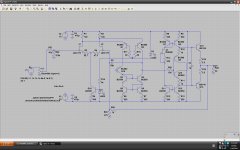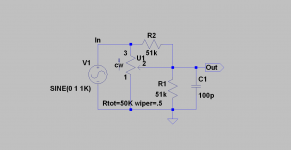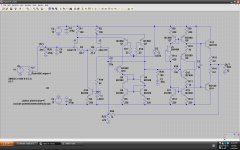I recently simulated a simpler amplifier based on a Folded Cascode topology:
-2SK170 LTP
-BC560C Folded Cascode Pairs
-Diamond Buffered
Feedback resistors: RF=1K, RG=470 (Giving around a Gain of 3)
Input Base stopper = 470, Input resistor to ground = 470K, Volume pot = 50k
I ran into square wave peaking/ringing issues when the pot is at 50% position. I'm not very smart at figuring it out how it works so I wanted to ask why it happened and the ways to compensate for such errors?
I tried using a 100pF to ground on the input and it helped tremendously. However, why does it help? Does it have to do with the source impedance interacting with the input capacitance of the input JFETS?
Thank You.
I'll post the schematic if someone requires but I'm having line issues now so posting pictures is a bit hard.
-2SK170 LTP
-BC560C Folded Cascode Pairs
-Diamond Buffered
Feedback resistors: RF=1K, RG=470 (Giving around a Gain of 3)
Input Base stopper = 470, Input resistor to ground = 470K, Volume pot = 50k
I ran into square wave peaking/ringing issues when the pot is at 50% position. I'm not very smart at figuring it out how it works so I wanted to ask why it happened and the ways to compensate for such errors?
I tried using a 100pF to ground on the input and it helped tremendously. However, why does it help? Does it have to do with the source impedance interacting with the input capacitance of the input JFETS?
Thank You.
I'll post the schematic if someone requires but I'm having line issues now so posting pictures is a bit hard.
Pot at 50% is the highest source impedance
Think about a 50K pot driven by a low impedance generator.
If the pot wiper is at the top, the impedance looking into the wiper is the 50 K pot in parallel with the generator's low impedance.
In the middle, Z looking into the wiper is 25K||25K, or 12.5 K, the max for this pot.
Near the bottom, Z looking into the wiper is something near zero in parallel with 50K, or nearly zero.
So, 50% is the worst case.
Many amps become cranky (unstable) with high source impedance...that's what happened at 50% pot setting with no capacitance on the input.
Think about a 50K pot driven by a low impedance generator.
If the pot wiper is at the top, the impedance looking into the wiper is the 50 K pot in parallel with the generator's low impedance.
In the middle, Z looking into the wiper is 25K||25K, or 12.5 K, the max for this pot.
Near the bottom, Z looking into the wiper is something near zero in parallel with 50K, or nearly zero.
So, 50% is the worst case.
Many amps become cranky (unstable) with high source impedance...that's what happened at 50% pot setting with no capacitance on the input.
wow that's fast, thanks!
so the most elegant and simple method is simply use a 100pF to ground capacitor on the input like most DIYAUDIO designs here do?
I've seen some designs like the Beta22 not using such capacitors and I kinda wondered how it's tested at 50% volume pot.
so the most elegant and simple method is simply use a 100pF to ground capacitor on the input like most DIYAUDIO designs here do?
I've seen some designs like the Beta22 not using such capacitors and I kinda wondered how it's tested at 50% volume pot.
I just tried simulating it again, and adding capacitors to ground distorts the square waves at higher frequencies. Seems to add a lot of phase shift. 
I tried the damping resistors but it does not seem to work that well either.
Anyway, I tried tweaking the compensation capacitor on the VAS to the inverting input and surprisingly I get to remove the C to GND and 1MHz squarewaves looks much much better.
This instability is a headache though, I'm not sure how well this response in real life :\ Any other better compensation ideas?
I tried the damping resistors but it does not seem to work that well either.
Anyway, I tried tweaking the compensation capacitor on the VAS to the inverting input and surprisingly I get to remove the C to GND and 1MHz squarewaves looks much much better.
This instability is a headache though, I'm not sure how well this response in real life :\ Any other better compensation ideas?
Schematic in question posted:
If i use 22pF from VAS to Inverting input, results are seemingly better. Do you think this is stable on the long run? Phase margin is around 50 degrees with this configuration. Conventionally anything larger than 45 is nice but should i go higher?
The 100pF to ground seems to distort the high frequency square waves before it even reaches the amplifier (observed from V(In) and V(out))
If i use 22pF from VAS to Inverting input, results are seemingly better. Do you think this is stable on the long run? Phase margin is around 50 degrees with this configuration. Conventionally anything larger than 45 is nice but should i go higher?
The 100pF to ground seems to distort the high frequency square waves before it even reaches the amplifier (observed from V(In) and V(out))
Attachments
Designing an audio amp to make pretty 1MHz square waves is (in my opinion) completely unnecessary and just asking for a world of trouble. Yes it *can* be done but considering the pain involved in ensuring good stability over a wide range of conditions, any potential benefits quickly hit the law of diminishing returns.
Schematic in question posted:
If i use 22pF from VAS to Inverting input, results are seemingly better. Do you think this is stable on the long run? Phase margin is around 50 degrees with this configuration. Conventionally anything larger than 45 is nice but should i go higher?
The 100pF to ground seems to distort the high frequency square waves before it even reaches the amplifier (observed from V(In) and V(out))
This way you cannot control the volume in the required range anymore
Some resistors at input JFETs' drains may help as well, but why worry about that phase shift? (a serious question really), try lower value cap to ground if you don't feel well with the bandwidth.
RF filtering
adding the cap across r20 creates an input filter.
The source resistance seen by the cap determines the frequency of roll off of this low pass filter.
With a 50k pot at the input and a small value for the cap (say 100pF) the Rs seen by the cap varies from 470r to ~13k.
The roll-off frequency varies over a range of 26times, i.e. from 3.4MHz down to 120kHz.
Yes, this is bound to have a variable effect on unfiltered squarewaves.
Do you really need an input impedance of 470k? Could you manage with 100k or 200k.
Does the input pot need to be 50k, would 20k or 10k do the job just as well?
Finally, I'd suggest a phase margin exceeding 60degrees and preferably around the 80degrees suggested by a few here that understand stability and signal overshoot.
adding the cap across r20 creates an input filter.
The source resistance seen by the cap determines the frequency of roll off of this low pass filter.
With a 50k pot at the input and a small value for the cap (say 100pF) the Rs seen by the cap varies from 470r to ~13k.
The roll-off frequency varies over a range of 26times, i.e. from 3.4MHz down to 120kHz.
Yes, this is bound to have a variable effect on unfiltered squarewaves.
Do you really need an input impedance of 470k? Could you manage with 100k or 200k.
Does the input pot need to be 50k, would 20k or 10k do the job just as well?
Finally, I'd suggest a phase margin exceeding 60degrees and preferably around the 80degrees suggested by a few here that understand stability and signal overshoot.
Last edited:
First of all, thank you all  .
.
Thank you AndrewT, you're a life saver with these straight forward solutions.
 Alps RK27 50k. I have a few of those left and I'd rather use them instead lol. I would probably use 10k for the real thing.
Alps RK27 50k. I have a few of those left and I'd rather use them instead lol. I would probably use 10k for the real thing.
I've changed the value of the 100pF cap to 10pF and it simulates well at 100KHz. I think if it's good at 100KHz I can be happy enough. I would put some series resistors to the 10pF for damping. (to be tested later)
As for amplifier compensation, I've added a typical series resistor and cap between the VAS and the Buffer and phase margin is above 90 degrees. I think with this I'll be safe enough.
adding the cap across r20 creates an input filter.
The source resistance seen by the cap determines the frequency of roll off of this low pass filter.
With a 50k pot at the input and a small value for the cap (say 100pF) the Rs seen by the cap varies from 470r to ~13k.
The roll-off frequency varies over a range of 26times, i.e. from 3.4MHz down to 120kHz.
Yes, this is bound to have a variable effect on unfiltered squarewaves.
Do you really need an input impedance of 470k? Could you manage with 100k or 200k.
Does the input pot need to be 50k, would 20k or 10k do the job just as well?
Finally, I'd suggest a phase margin exceeding 60degrees and preferably around the 80degrees suggested by a few here that understand stability and signal overshoot.
Thank you AndrewT, you're a life saver with these straight forward solutions.
I've changed the value of the 100pF cap to 10pF and it simulates well at 100KHz. I think if it's good at 100KHz I can be happy enough. I would put some series resistors to the 10pF for damping. (to be tested later)
As for amplifier compensation, I've added a typical series resistor and cap between the VAS and the Buffer and phase margin is above 90 degrees. I think with this I'll be safe enough.
Attachments
- Status
- This old topic is closed. If you want to reopen this topic, contact a moderator using the "Report Post" button.
- Home
- Amplifiers
- Solid State
- Instability caused by volume pot at 50%?


